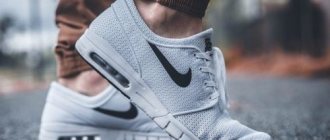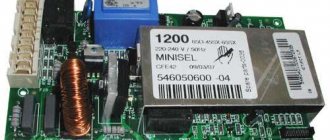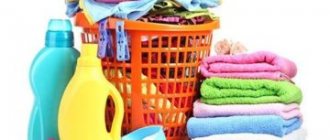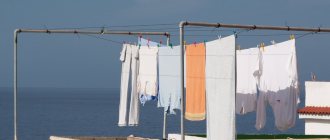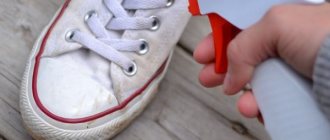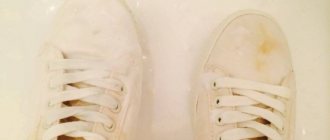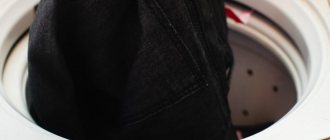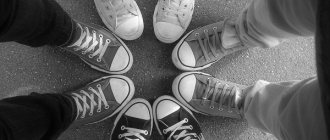White sneakers need washing. However, after such treatment, you may encounter a problem, namely, yellowness that appears on a sports pair.
There is no need to despair. There are several effective ways to combat this problem.
Why did white sneakers suddenly turn yellow after washing or have yellow stains on them, what should I do about it? Find answers to your questions in the article.
Preparing to wash white sneakers
Yellowness and stains on textile shoes can appear for reasons such as poor-quality washing powder or improper drying. But most often the result is disappointing due to improper preparation of the sneakers for washing.
So, before washing light-colored sneakers or sneakers, you must:
- remove insoles and laces from shoes;
- shake out the sand, using available means, remove chewing gum or bitumen from the sole;
- remove all small pebbles from the sole with a deep tread pattern - they can damage the washing machine;
- Wash off large dirt from shoes under running water and soap.
Only after these manipulations can you begin the main wash.
Why do white textile shoes turn yellow after washing?
If white sneakers turn yellow after washing, then in order to return the previous color you will need to understand the reasons for the appearance of yellow spots. So why do white sneakers turn yellow after washing? There are several reasons.
If your fabric sneakers have turned yellow, you should pay attention to how they were dried. Many owners of white sneakers like to speed up the drying process after washing them by exposing them outside to direct sunlight.
But ultraviolet radiation has a detrimental effect on white fabric shoes in the form of yellow spots.
Therefore, knowledge of how to wash white sneakers is not yet enough
It is equally important to know about the rules for drying them after washing so that they do not turn yellow. You can prevent the appearance of yellow spots on white sneaker fabric with the help of a properly selected place for drying.
The ideal option would be a balcony or other area that provides excellent ventilation. During the cold season, you can use special drying devices for shoes.
To prevent white sneakers from turning yellow after washing, you need to perform a number of steps. First you need to let the water drain by hanging the boots by the toe. After an hour, you can remove the shoes and use a towel to remove any remaining excess moisture. After all the procedures, you should hang it by the laces and wait until they dry completely.
Another reason that the sneakers have turned yellow may be poor rinsing. If you use little water, the powder will not rinse well. This will be the reason why yellow spots appear on the fabric of white sneakers.
To prevent sneakers made from white fabric from turning yellow, you should spend more time rinsing them. First, two times, you should use hot water, which helps to better remove the powder from the fabric. After this, it is recommended to change the hot water to cool. Using a sponge and active rinsing, you need to completely rid your sneakers of powder. The last step should be soaking the white sneakers. To do this, you will need a basin with warm water and a small amount of acetic acid (2 tablespoons). After the boots are completely covered with water, they must be left for 30 minutes.
The next reason that the boots have turned yellow may lie in the wrong detergent. If the powder is of low quality, then the likelihood of yellow spots appearing on the textile surface of the shoe increases.
In rare cases, shoes turn yellow after washing because they were not prepared correctly.
Due to chemical reactions that occur after the interaction between the powder and the sole material, yellow spots may also appear.
If the crosses have turned yellow, the reason may lie in bad water. When washing with cloudy water or with rust particles, similar problems may occur.
Often yellow spots appear from the inside of textile shoes. Increased sweating of the wearer of the sneakers can contribute to this. Sweat can easily cause yellow spots to appear. Even the most careful people are not immune to such a problem as yellow stains on the white fabric of sneakers. So how to deal with them?
Products for washing white sneakers to avoid yellow stains
Many modern household chemicals can remove stains and prevent the appearance of yellow stains on white sneakers after washing. The best proven ones:
- liquid washing gels - they dissolve well even in cold water;
- regular washing powders of a proven brand;
- dishwashing detergent or liquid soap. However, due to excessive foaming, they are recommended for hand washing only;
- oxygen bleaches.
Important! Do not clean light-colored textile shoes with chlorine bleaches. Chlorine can weaken fabric fibers and cause significant damage to rubber soles. Gasoline, turpentine and other solvents also have aggressive cleaning properties.
Important Tips
To avoid harming your sneakers when trying to remove yellow stains from them, you must follow these recommendations:
Any new product should be tested on an inconspicuous area of the sneaker.- White shoes should be washed separately from colored ones, so as not to provoke the appearance of new stains.
- It is recommended to wash white shoes by hand and not in a machine. This will allow you to immediately notice the stains and work on the desired area especially carefully.
- Powdered detergents should not be used to wash shoes. Their components do not dissolve well in cool water, and therefore do not provide the required washing quality.
- You need to dry your sneakers in natural conditions. They should not touch each other or other surfaces. You can place a white dry cloth or paper inside. When it becomes saturated with moisture, it is removed and replaced with a new one. Such manipulations must be repeated until the filler ceases to be actively moistened.
You need to rinse your sneakers by hand especially carefully. If cleaning agent particles remain in them, the shoes may crack.
Washing methods
Almost all sneakers can be washed either by hand or in a washing machine. The manual method will be effective for minor stains. If the sneakers have not been washed before, then it is better to try the first water procedures manually. It is recommended to use machine washing in case of heavy soiling, or in the case when the white sneakers have already turned yellow after washing.
Handwash
To wash sneakers by hand you will need a small basin, washing powder or gel, and a toothbrush. Cleaning will occur in several stages.
- Fill the basin halfway with warm (not hot!) water.
- Thoroughly stir the powder or liquid detergent into the water.
- Put the sneakers, removed insoles and laces into the solution. The water must completely cover the shoes, otherwise dirty stains will appear.
- Leave the soaked items for several hours.
- After the specified time, remove the sneakers from the solution. If there are stains on the fabric or side rubber surfaces, you can additionally scrub them with a toothbrush and soap.
- Thoroughly rinse the sneakers, as well as the insoles and laces under running water.
- Place the shoes upright and let the water drain.
Now the shoes are clean and ready to dry!
Machine washable
It is much easier and faster to wash white sneakers without yellow stains in the machine. However, there are a few tricks here too.
- Heavy soiling must be treated before machine washing. Wipe each stain on the fabric with a brush and soap, and walk over the rubber flaps on the heels or toes. You can remove black stripes from socks with a regular office eraser.
- It is recommended to wash sports shoes in a special mesh bag. You can add insoles (not paper-based!) and laces to your sneakers. If you don’t have such a bag in your household, a thin old pillowcase will replace it.
- The washing mode should be as delicate as possible, water temperature – up to 40 degrees . It is better not to turn off the spin, but to set the minimum speed.
- Additional rinse. This function completely removes detergent from fabric fibers and prevents the appearance of yellow stains.
Sometimes machine washing is preceded by hand washing, for example, in case of heavy soiling. In this case, the washing algorithm remains unchanged, except that a smaller amount of detergent is required. The water temperature in the machine should also be lowered to 30 degrees - this will reduce the deformation of the fabric.
Bleaching yellowed rubber and uppers on sneakers and sneakers
Some people recommend using bleach to remove rubber stains. But bleach will make the rubber brittle over time. Luckily, there are many other bleach-free options for removing rubber stains.
Specialized purchased products
You can find eraser-like products that get rid of stains. The secret of the erasers is simple - melamine foam. The properties of the melamine sponge make it an excellent stain remover. The foam has a very porous texture that allows you to literally scrape dirt out of the pores on your shoes.
The only downside is that melamine sponges wear out quickly - just like the eraser on pencils.
Cleansing wipes
One wipe is enough to clean one pair of lightly soiled shoes, so the whole package will last for half a month of daily use. Good wipes are very well saturated, even after treating one pair of shoes they remain wet without leaving streaks.
Special wipes for shoes can be coated with a composition that cares for the products, protecting them from environmental influences.
Bleach and soap
Work in a well-ventilated area and wear clothes that you are not afraid of getting splashed with bleach if something happens.
Fill the container with approximately 2 liters of warm water. Add 1 tbsp. l. liquid soap in water and 0.4 liters of bleach. Stir the solution until the soap is distributed and bubbles form.
Dip a clean cloth or rag into the solution. Squeeze out excess. Wipe the dirty rubber thoroughly until it is clean. Afterwards, wash off the remaining solution from the rubber surface with running water.
Do not use abrasive cleaners or tools. They can deform the rubber surface.
Toothpaste or powder + brush
Use white toothpaste without gel. Colored paste can stain shoes.
Apply some white toothpaste to an old, soft, clean toothbrush. Clean contaminated areas thoroughly using circular motions. Continue cleaning until the dirt is gone. Remove any remaining toothpaste with a clean, damp cloth. Be sure to thoroughly remove all traces.
Do not apply toothpaste to leather, suede or silk as they may absorb it.
Hydrogen peroxide and ammonia
Their diluted solutions can be used to clean rubber on white sneakers and sneakers.
Use of the mixture:
- mix 1/2 tablespoon of ammonia, 1/2 tablespoon of hydrogen peroxide and 1/2 tablespoon of warm water;
- Dip an old toothbrush into the solution and clean the dirty area with it;
- rinse area with clean water, repeat if necessary.
Soda and liquid soap
Baking soda effectively helps remove stains from white shoes. This product is easy to prepare and can be stored for a long time.
5-7 drops of liquid soap and 250 grams of soda should be mixed in a container, stirring until thick foam forms to form a homogeneous dough-like mass. For a fresh aroma and additional bactericidal properties, you can add 5-6 drops of tea tree or juniper essential oil. If you like citrus scents, add a few grains of citric acid.
Cleaning sneakers and sneakers is similar to the situation with using hydrogen peroxide and ammonia.
Vinegar and acetone
Acetone is a strong chemical solvent that can effectively remove stains from rubber surfaces. At the same time, it also affects the rubber, causing it to swell, but practically without changing its mechanical properties. After cleaning, swollen products can return to their original size.
With prolonged and repeated use of acetone, sneakers and sneakers can be irrevocably damaged.
Vinegar has proven itself as a cleaning agent that kills bacteria and removes grease and dirt stains. In most cases, diluted vinegar is safe for rubber seals. Pure vinegar cannot be used, as there is a high probability of damaging the rubber.
Nail polish remover
- Remove dirt from white rubber.
- Soak a cotton pad with nail polish remover.
- Start cleaning. As you clean the rubber, they will become brighter.
Do not use nail polish remover on fabric areas of shoes.
Potato starch and milk
Mix them in equal proportions. Lubricate the sole generously and leave for 10 minutes. Afterwards, go over the sole with a brush and rinse everything off with water.
Removing already formed yellow spots and stains
What should you do if, despite your efforts, after washing your sneakers turn yellow or have streaks on them? Heavy artillery in the form of folk remedies will come to the rescue!
For large stains, you can rinse your shoes with the addition of food acids - acetic or citric. You can do this manually - soak the sneakers in cold water with a small amount of acid, then rinse thoroughly.
To achieve spectacular whiteness, hydrogen peroxide along with ammonia is useful. These products can be applied locally - only on yellow spots, or added to water when rinsing. Regular toothpaste, but only white, will help remove stains.
Sometimes yellow stains disappear if you simply rinse the shoes in the machine without adding any chemicals. This means that there is washing powder left in the fibers, which reacted with the fabric in the air. Hence the appearance of unwanted yellowness.
Sole bleaching
Eraser
You need to use a white eraser that does not leave streaks on the surface.
- Use an eraser to work through the corrugated sole, making sure not to miss a single indentation, thoroughly removing yellowness, dirt and black stripes.
- When finished, wipe the product with a clean soft cloth.
There is no need to use water with this cleaning method.
For one pair of shoes you need to take a fairly large eraser. If the surface of the sole is uneven, then small pieces will be needed to clean the grooves. The hard side of the eraser can damage the structure of the material. Use only its soft side.
Lemon or citric acid
Citric acid is environmentally friendly and is a good alternative to other harsh cleaning products that can be harmful and toxic. It's easy to use:
- Rub the problem area with a slice of lemon or powder.
- Leave for 15-20 minutes.
- Rinse off with running water.
Solvent
Before using any solvent, carefully read its instructions. Methylated alcohols can cause permanent damage to rubber soles. Many detergents, including acetone, are flammable.
To clean white soles, it is recommended to use:
- Medical alcohol.
- Mineral spirits packed in metal cans.
- Acetone.
They evaporate quickly and are easy to acquire.
Other solvents are effective in cleaning, but slow evaporation can be a problem. They can also leave stains on sneakers and trainers. These solvents include turpentine and d-limonene.
Naturally, before applying solvent to a rubber surface, it is recommended to conduct an “out of model” test.
Do not allow the solvent to soak into the material or leave it on for too long.
How to dry white sneakers correctly
Very often, the cause of yellow spots is improper drying of shoes. After cleaning, sneakers or sneakers should not be placed near radiators, heaters or under the scorching rays of the sun! The fabric dries unevenly and yellow streaks appear.
The best way to dry light-colored sports shoes is to hang them by the laces in a shaded place with good air circulation. It is recommended to stuff the inside of sneakers with foam rubber lining with white napkins. The paper will absorb excess moisture and speed up drying. Never use newspaper - the printing ink will leave imprints on the shoes! Place the insoles on a horizontal surface. With this method, the appearance of yellow spots on sports shoes is unlikely.
Helpful tips for snacks.
- Treat your shoes with clean white cotton rags so that they do not fade from soap and water on your shoes.
- Do not use alcohol-containing products or vinegar without baking soda; they may leave yellow streaks.
- The final stage of all procedures is wiping with a clean damp cloth and then dry. It is necessary to finally remove any remaining dirt and cleaning agent. Don't forget to do this.
- Take care of your shoes from the moment of purchase - protect them from dirt and water with special products, use colorless wax-based creams, wipe them every time after a walk.
- Do not store white shoes next to colored ones. They say she doesn't like it and turns dark. He's probably jealous)
How to bleach yellowed sneakers
Not only dirt can ruin the appearance of white shoes. It also happens: you spent time, effort, and bleaching powders to return your favorite sneakers to their whiteness, but during the drying process they became covered with yellow spots. There may be several reasons for this injustice:
- washing was carried out in excessively hot water;
- during rinsing, part of the powder remained and reacted with the material;
- sneakers were dried in direct sunlight or on a radiator, which could cause the shoes to fade.
If yellow stains appear on sneakers or sneakers, hydrogen peroxide will help correct the situation.
- Soak the sneakers in cold water for several hours, then rinse thoroughly.
- Drain the water from the shoes, blot the inside and outside with paper towels, then stuff the inside with white paper and dry at room temperature or in the shade outdoors.
- If this is not enough, prepare a bleach solution from equal parts hydrogen peroxide, vinegar and fresh lemon juice with a tablespoon of laundry detergent. You should get a creamy mass. Apply it to the yellow areas using a toothbrush or dish sponge and leave for 5-7 minutes. Remove the mixture with a napkin and rinse the shoes under the tap with cold water. Carry out drying according to the rules described above.
Yellow stains on rag shoes may appear after washing
Video: how to remove yellow stains from white leather sneakers
How to get rid of yellowness on artificial leather
If a pair of faux leather sneakers has turned yellow, you can remove the stains with soap and water or laundry detergent. Apply the solution with a brush, then rinse with a clean damp cloth, and then wipe the surface dry. Yellowness can also be removed using nail polish remover or hydrogen peroxide. Soak a cotton swab in hydrogen peroxide and wipe the damaged area on the sneakers. To enhance the effect, you can add a few drops of ammonia to the peroxide.
White shoes characterize the one who wears them as a neat, non-lazy person and a true connoisseur of beauty. Flaunt yourself in white shoes, enjoy life and the smiles of passers-by. And in case of troubles - gray plaque, yellowed spots and other contaminants - you now know what to do.
Stain removers, soaps and improvised products
To combat dirt, purchase one of the popular stain removers. This is the simplest method of salvation from this kind of incident. You can also wipe off yellow marks with regular baby soap. Table salt will help clean cotton material: dilute 1 tbsp. l. in water (1 glass) and wet the stain well, then wash. For similar materials, it will be useful to clean with hair lightening powder, which must be diluted with a nine percent oxygen agent.
Duru laundry soap helps to defeat yellowness. Remember that contaminants disappear faster in cold water. In principle, it is better to send all white items into the wash at a programmed temperature of no higher than forty degrees. Try washing untidy marks in the machine for two hours by adding chlorine bleach. However, be aware: a product with chlorine can ruin the item. The composition of the bleach negatively affects the fibers of matter, which leads to their destruction. Also, stains removed with chlorine may come back. When you've tried several methods and nothing works, try boiling your clothes. Don't forget to add a small amount of powder to the water - this will help enhance the effect.
What will you need?
If you have white textile shoes (not necessarily sneakers, it can be slippers, or even shoes that turn yellow), it is very useful to keep in full combat readiness the means that you may need at any moment:
- liquid soap;
- bleach without chlorine;
- white fabric dye (spray);
- ammonia;
- table vinegar;
- hydrogen peroxide;
- citric acid (replaced with lemon juice);
- cotton pads;
- toothbrush;
- dentifrice;
- toothpaste;
- white paper napkins;
- white paper.
Why did the tracks appear?
Why do sneakers turn yellow after washing, what causes the unpleasant marks to appear? Please read this list carefully to avoid contaminating the surface of your shoes in the future:
You can remove stains from sneakers after washing! But you have to try - we have collected several effective methods, choose!
How to wash by hand
Hand washing is more gentle. It is suitable even for elegant models decorated with rhinestones. There are several ways to clean white sneakers without leaving yellow stains on them.
For cleaning and washing you will need a soft brush. It is convenient to use an old toothbrush, as it will allow you to treat the gaps between the rings and all the tight spots.
Before you start washing your sneakers, you need to prepare them, just like with the machine cleaning method. If necessary, high-quality products can be soaked in warm water with powder for white fabrics diluted in it. The water temperature should not be higher than 30°C, and the soaking time should not be more than half an hour. However, if you are not confident in the strength of the products, it is better to avoid soaking. Inexpensive models may simply fall apart.
An alternative to soaking is soaping. After soaking the brush in water and lathering it with laundry soap, treat the fabric part of the shoes and leave to stand for 20-30 minutes. After this, thoroughly clean the entire surface with a dampened soapy brush. If there are no stains, after cleaning it is enough to rinse the shoes well in cool water several times.
How to clean insoles
When processing insoles, you need to focus on the material. Leather inserts should not be soaked in water or machine washed. They require special care:
- Wipe the surface with a dry cloth. This will remove dust and dirt.
- Apply hydrogen peroxide to problem areas using a cotton swab.
- After 3-5 minutes, wipe the insoles with a slightly damp cosmetic pad.
- Let the earbuds dry.
Important: Do not use strong chemicals such as acetone, alcohol or bleach for cleaning. Their use may damage leather insoles.
Rag products are more easy to care for. You can clean them using a regular soap solution, following these simple steps:
- Dissolve a few drops of liquid soap or a small amount of washing powder in a bowl of warm water.
- Place the insoles inside. Leave them for 5-7 minutes.
- Go over the entire surface of the fabric with an old toothbrush. This will help remove most of the dirt from them.
- Wipe the fabric liners with a clean, damp cloth, finally removing any soapy water from them.
- Leave the insoles to dry for 24 hours, placing them on a terry towel. After this time, your sneaker inserts will take on a new look.
Drying rules
A common reason for the appearance of streaks on a down jacket is errors during drying. Drying winter clothes properly is almost more important than washing them properly. It's all about the “capricious” filler, which does not tolerate water well. Pooh can:
- clump together in dense lumps;
- start humming and “emitting” an unpleasant odor;
- lead to the appearance of stains on the down jacket.
The choice of drying method depends on several conditions - the type of filler, the size of the “cells”, the fabric of the “top”, the washing method, the recommendations on the product label. As a rule, the manufacturer indicates the preferred drying method - horizontal or suspended. The following recommendations are general for any winter clothing:
- You need to start drying your down jacket immediately after washing. Do not leave a wet product lying in the basin or drum of the machine.
- Spinning in the washing machine (at minimum speed) will significantly speed up the drying process. You cannot wring out items with down filling by twisting them.
- Good ventilation. The drying room should be well ventilated (the bathroom is not suitable, it is too damp there, so the drying process will be delayed).
- It is correct to dry a down jacket in a straightened, unbuttoned position. Air must come from all sides. To do this, you can hang the product on hangers. If the manufacturer recommends drying a down jacket horizontally, it should be laid out on the dryer rack to ensure even drying.
- Do not dry your down jacket on a radiator, heater, or in direct sunlight. The occurrence of divorces is almost inevitable.
- During the drying process, the down jacket should be shaken and turned over frequently (for example, every hour). This is necessary to prevent the fluff from compacting and starting to fray. Alternatively, you can beat the fluff with blows from a carpet flapper or a stick.
How to dye textile shoes
Sometimes it is not possible to remove yellow stains. Perhaps they turned out to be too persistent, so even strong remedies do not help. If the shoes look decent, then you shouldn’t throw them away. It will be enough to paint to eliminate yellowing.
Of course, it is not easy to achieve a good result on your own. You'll have to carefully study the instructions to get your yellow sneakers in good shape. You will need to purchase special paint for textile shoes. They are sold in powder and spray form. Dyes come in both white and colored. Before purchasing, you will have to carefully study the instructions on the package.
You need to carefully paint your shoes so that they look natural. In addition, you will have to let it dry well. If everything is done correctly, the result will certainly please you.
Why do sneakers turn yellow after washing?
To return your sneakers to their former white color, you need to understand why they turn yellow in the first place. What is the nature of yellow spots? Maybe this will help in the fight against them. There can be several reasons for yellowness on shoes.
One of the most common reasons is improper drying. Most shoe owners, in order to speed up the process, dry their shoes outside in the sun. Indeed, this way the sneakers dry faster, but after a while they begin to turn yellow under the influence of ultraviolet radiation.
Perhaps not immediately, but after several dryings. Rinse in a small amount of water. In other words, the laundry detergent was poorly rinsed from the sneaker fabric, which after drying appeared in the form of yellow spots. The water for washing and rinsing should be warm, but not hot! This can also cause your sneakers to turn yellow. Another reason is an incorrectly selected detergent or poor quality of such a detergent. Rarely, yellow spots can be caused by improper preparation of shoes for washing. The reason may be chemical reactions during the interaction of the powder and the sole material. Pay attention to the water in which you are going to wash your sneakers. Is it clean? It happens that water pipes are replaced in a neighborhood, and then small particles of rust appear in the water, and the water becomes cloudy.
Yellow spots can appear not only on the outside of the shoe, but also on the inside. People who suffer from excessive sweating may develop yellow spots due to sweat. If washed incorrectly, such stains will appear. No matter how careful you are, you will have to deal with these stains somehow.
Bleach and soap
The first thing that comes to mind when removing stains from white fabric is, of course, bleach. There are many of them, but it is best to choose oxygen. Before washing your sneakers with bleach, you need to prepare them:
- remove the laces and insoles;
- Wash the sole from dirt.
Next, the shoes are soaked in warm water with the addition of bleach or washing powder with bleaching properties for a couple of hours. But this does not mean that they need to be put in water and left for two hours. From time to time, the sneakers need to be rubbed with a brush, you can use a toothbrush. We clean not only the top of the shoe, but also the inside.
If the yellow spots do not respond, we take tooth powder. Pour the powder onto the stain and clean with a brush. You can repeat the soaking procedure a couple of times, changing the water. As soon as the sneakers acquire the desired color, start rinsing them, sparing clean water.
If the yellow spots have just appeared and are of a light shade, then you can try to bleach them with soap. Just take bleaching soap instead of laundry soap. For example, soap “Eared Nanny”, “Sarma”, “Clean & White”. Shoes need to be wet, soaped and rubbed, leaving for 30-40 minutes, then rinse off the foam. Repeat the procedure several times.
Toothpaste and brush
Toothpaste works well for yellowing shoes. For such purposes, it is not necessary to buy an expensive one; a regular one with a whitening effect will do. The color of the paste itself should also be white, without blue or red particles. Otherwise, instead of bleaching, the sneakers will be stained.
We perform the procedure as follows:
- lightly moisten the surface of the shoe, it should not be wet;
- Apply the paste to a damp sponge, white cloth or toothbrush;
- three contaminated areas of shoes;
- leave the paste for 20-30 minutes;
- clean everything again;
- wash off the paste;
- rinse thoroughly;
- dry.
Hydrogen peroxide and ammonia
An old proven remedy - ammonia - will help get rid of yellow stains on white sneaker fabric. Some people underestimate it due to improper use, but it still has its uses. Before the procedure, sneakers must be clean and dry. Take a bandage or cotton pad and moisten it with ammonia, rub the yellow area of the fabric. Leave for 20-30 minutes, rub again. The stains do not begin to fade immediately, so you have to repeat the procedure up to 10 times, which will require patience from you. Finally, the shoes are rinsed and dried.
You can restore the white color using hydrogen peroxide. To do this, it is mixed with vinegar and washing powder in a ratio of 1:1:1. The resulting paste is rubbed onto the sneakers and left to interact with the stains. After 30-40 minutes, wash off, rinse and dry.
Trying to paint over it
And finally, the last resort is to paint yellowed shoes. Stores offer special paint for shoes, which is very easy to use at home. The paint will hide not only yellowed areas of the fabric, but also other stains.
The paint is supplied in cans and instructions are included. Therefore, before use, read it carefully and do not neglect any point. As a result, you will receive new, snow-white sneakers.
What are the sneakers made of?
These comfortable and practical shoes are made of fabric, and rubber or plastic are used for the soles. Accordingly, you need to clean sneakers in the same way as any other textile shoes. That is, they can be washed and used with a variety of detergents. True, it is not recommended to use some powders, as well as bleaches and stain removers, in particular:
- chlorine powders and bleaches;
- petrol;
- kerosene;
- some types of solvents.
Important! In some cases, gasoline and solvents still have to be used. For example, if you knocked over a can of paint on your feet, but you don’t want to throw away your sneakers, you’ll have to take a risk. But after this, the shoes will have to be washed and bleached in other ways. If the sneakers are quite cheap, and the stains are serious, it is better to think about buying new, more practical products, but you will have to get rid of these. Then our rating of the best sneaker manufacturers will be useful to you.
